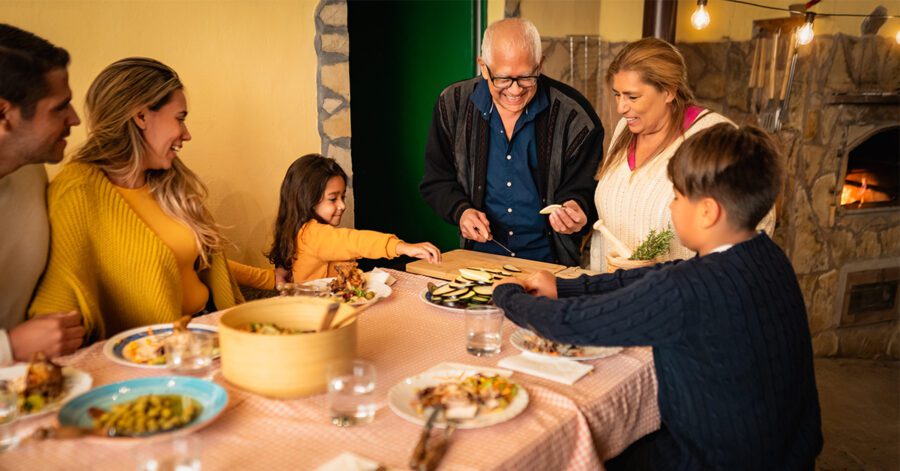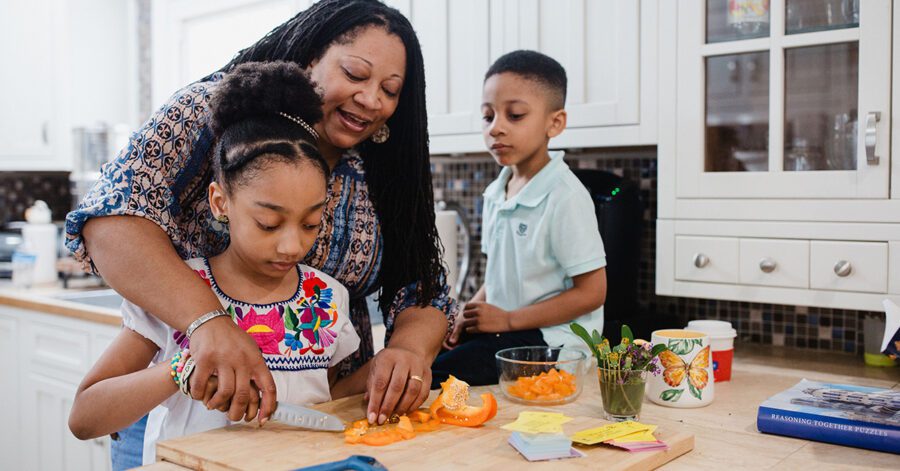November arrives with crisp air, golden leaves, and an invitation to slow down and give thanks. But what if gratitude became more than a single day’s focus? What if, throughout this month, your family cultivated hearts that notice beauty, name blessings, and worship the Giver of all good gifts?
As homeschool families, we have a unique opportunity to weave thanksgiving into the rhythm of our days—not as one more task to check off, but as a posture of the heart that shapes how our children see the world. Scripture calls us to “give thanks in all circumstances” (1 Thessalonians 5:18), and the classical tradition teaches us that repetition, observation, and reflection form habits that last a lifetime.
This November, as you practice these 27 gratitude activities for families, equip your children with a companion tool that makes daily thanksgiving tangible and memorable. Our free printable gratitude journal for children includes both writing and drawing prompts designed to guide young hearts through a month of reflection. Download it today and watch as your children fill its pages with wonder, worship, and thankfulness.
These individual and communal activities are quick and intentional. Some connect to classical education practices, such as memory work, narration, and observation. Others invite your family into service, creativity, and worship. All of them point your children toward a God who is faithful, generous, and worthy of all praise.
Begin with Reflection (Days 1-3)
1. Start a Gratitude Journal
This month, children can keep a daily gratitude journal with prompts that guide them to write or draw three things they’re thankful for. Use prompts like “I’m thankful for a person who…,” “I’m thankful for a place where…,” or “I’m thankful for something small today…” This becomes their companion throughout the month, a place where wonder is captured and worship begins.
Download our free printable gratitude journal for children to give your kids a beautiful tool for daily reflection. With both writing and drawing prompts, it’s designed to accommodate all ages and abilities.
Time: 10-15 minutes daily | Who: Individual
2. Create a Gratitude Jar for the Month
Decorate a jar together as a family using ribbons, paint, or fall-themed stickers. Each day, write what you’re thankful for on a slip of paper and add it to the jar. On Thanksgiving Day, empty the jar and read each slip aloud, celebrating all that God has provided. This visual reminder grows fuller each day, much like our awareness of God’s faithfulness.
Time: Initial setup 20 minutes, daily 3 minutes | Who: Family
3. Evening Gratitude Review
Before bed each night, each family member shares the best part of their day and thanks God for it. Make this a daily habit throughout November. Younger children might share one word or image; older children can explain in more detail. This simple practice closes each day with thanksgiving rather than worry, training hearts to seek the good.
Time: 5 minutes | Who: Family
Listen to The Truth About Thanksgiving on the Everyday Educator podcast
Scripture & Worship (Days 4-8)
4. Memorize a Psalm of Thanksgiving
Choose Psalm 100, 103, or 107 and work through it line by line as a family. Recite it together each morning, adding new verses as you memorize them. In classical education, memory work lays a foundation that serves students for years to come. When we memorize Scripture, we store up treasure that nourishes us in every season.
Start with just two lines. Echo them back and forth. Add a line each day. By Thanksgiving, you’ll have hidden God’s Word in your hearts.
Time: 5-10 minutes | Who: Family | Classical connection: Memory work, recitation
5. Create a Gratitude Prayer Chain
Cut paper strips in fall colors—orange, red, yellow, gold. Each day, write a prayer of thanks on a strip: “Thank You, Lord, for warm blankets,” “Thank You for laughter at the breakfast table,” “Thank You for the way the sun breaks through the clouds.” Loop each strip through the previous one, creating a growing chain of thanksgiving. Drape it across a doorway or hang it in your schoolroom. Pray through it at bedtime, remembering all the ways God has shown His kindness.
Time: 5 minutes | Who: Family
6. Sing Hymns of Gratitude
Learn “Great Is Thy Faithfulness,” “Count Your Blessings,” or “The Doxology.” Sing them as morning worship or during family devotions. Hymns carry theology in melody, teaching our children to think rightly about God while training their voices in beauty. The repetition of singing the same hymn daily throughout November makes it a companion to your gratitude practice, a song that rises naturally when hearts overflow.
Time: 10 minutes | Who: Family | Classical connection: Integration of the arts
7. Scripture Copywork for Thankfulness
Have children copy 1 Thessalonians 5:18 (“Give thanks in all circumstances; for this is God’s will for you in Christ Jesus”) or Colossians 3:17 (“And whatever you do, whether in word or deed, do it all in the name of the Lord Jesus, giving thanks to God the Father through him”) in their best handwriting. Illustrate the verse with fall colors, symbols of harvest, or images that represent what they’re thankful for. They can add these pages to their gratitude journals or practice in the Prescripts Cursive Words: Scripture book.
Copywork is a grammar-stage practice that trains the hand, the eye, and the heart. When children write Scripture slowly and carefully, the words sink deeper.
Time: 15-20 minutes | Who: Individual | Classical connection: Copywork, grammar stage
8. Read a Parable of Gratitude
Read Luke 17:11-19 together—the account of ten lepers healed by Jesus. Only one returned to give thanks. Discuss: Why did only one come back? What does it mean to return and give thanks? How can we be like the one who remembered? Children can reflect on this parable in their journals, drawing the scene or writing their own prayer of thanks.
Time: 10 minutes | Who: Family
Read Reasons to be Thankful for Homeschooling this Thanksgiving
Observation & Wonder (Days 9-13)
9. Go on a Gratitude Walk
Take a nature walk and thank God aloud for specific things you observe: the veins in a red oak leaf, the way light filters through the trees, the crunch of frost beneath your feet, the industrious squirrel gathering acorns. The classical habit of attending begins with noticing. When we train our children to observe closely, we teach them that the world is full of gifts worth naming.
Return home and record your observations in journals or discuss them over hot cider.
Time: 20-30 minutes | Who: Family | Classical connection: Observation, attention
10. Draw What You’re Thankful For
Younger children can draw freely—a favorite toy, a beloved pet, a sibling’s smile. Older children can practice careful observation, sketching a still life of autumn’s bounty: apples, pumpkins, gourds, wheat. Display the drawings together or add them to gratitude journals. Drawing trains the eye to see and the hand to render beauty, grounding abstract gratitude in concrete images.
Time: 15 minutes | Who: Individual
11. Five Senses Gratitude
Name one thing you’re grateful for that you can see, hear, smell, taste, and touch. This exercise grounds thanksgiving in the physical world God created. You might be grateful for the sight of your child reading, the sound of rain on the roof, the smell of bread baking, the taste of apples fresh from the orchard, the feel of a hand slipping into yours.
Record these in your gratitude journal.
Time: 5 minutes | Who: Individual or family
12. Gratitude Nature Journal
On your next nature walk, collect a leaf, seed pod, acorn, or small natural object. Press it in your Nature Sketch Journal and write why you’re thankful for God’s creation. Perhaps the acorn reminds you that God grows mighty oaks from small beginnings. Perhaps the milkweed pod speaks of provision for monarchs on their long journey south. Let nature teach your children to see God’s hand everywhere.
Time: 20 minutes | Who: Individual | Classical connection: Nature study
13. Stargazing & Thanksgiving
On a clear evening, bundle up and look at the stars together. Recite Psalm 8:3-4: “When I consider your heavens, the work of your fingers, the moon and the stars, which you have set in place, what is mankind that you are mindful of them, human beings that you care for them?” Thank God for His vastness and His care, for the way He numbers the stars and knows your children by name.
Journal about the experience afterward, capturing both the wonder of the sky and the comfort of being known.
Time: 15 minutes | Who: Family
Listen to Refining Rhetoric: Thank YOU!
Memory & Narration (Days 14-17)
14. Tell a Family Gratitude Story
Parents, share a story from your childhood about a time someone showed you kindness—a neighbor who brought soup when you were sick, a teacher who believed in you, a friend who stood by you. Tell it with detail and warmth. Then invite your children to narrate it back in their own words, practicing the classical skill of oral narration.
Stories form us. When children hear accounts of gratitude lived out, they learn what thanksgiving looks like in real life.
Time: 10-15 minutes | Who: Family | Classical connection: Narration
15. “Alphabet of Gratitude” Recitation
Go through the alphabet together, naming something you’re thankful for that starts with each letter. A is for apples and autumn. B is for books and bread. C is for community and Christ. Let younger children call out words freely. Challenge older children to think of items related to your studies—artists, composers, historical figures, scientific terms.
This exercise trains memory, expands vocabulary, and fills the mind with thanksgiving.
Time: 10 minutes | Who: Family
16. Memorize a Gratitude Quote
Choose a quote to memorize and recite together. Try Cicero: “Gratitude is not only the greatest of virtues, but the parent of all the others.” Or G.K. Chesterton: “When it comes to life, the critical thing is whether you take things for granted or take them with gratitude.”
Practice reciting it together throughout the week. Copy it into journals in beautiful handwriting. Let the words shape the way your family thinks about thanksgiving.
Time: 5 minutes | Who: Family | Classical connection: Memory work
17. Gratitude Memory Timeline
Create a visual timeline of your year so far (January through November). Have each family member add drawings or words representing moments they’re grateful for from each month.
This helps children practice sequencing and reflection while celebrating God’s faithfulness throughout the year.
Time: 20-30 minutes | Who: Family | Classical connection: Timeline work, chronological thinking
Explore 6 Fun Thanksgiving Homeschool Activities
Service & Community (Days 18-23)
18. Write Thank-You Notes
Children write cards to teachers, Tutors, Directors, pastors, neighbors, or anyone who has enriched their lives. Be specific: “Thank you for teaching me about the Trojan War. I loved hearing you tell the story of the wooden horse.” Specificity shows that you’ve truly noticed and appreciated someone’s gift.
Address the envelopes together. Mail them or hand-deliver them. Watch your children’s faces as they realize their words have power to encourage.
Time: 15-20 minutes | Who: Individual
19. Bake and Share
Make cookies, muffins, or pumpkin bread together as a family. Package them in simple bags tied with ribbon and deliver them to a neighbor, your mail carrier, a firefighter at the local station, or someone who serves your community faithfully. Include a handwritten note: “Thank you for serving our neighborhood. We’re grateful for you.”
Gratitude moves from word to deed when we give our time and our hands to blessing others.
Time: 1-2 hours | Who: Family
20. Donate Outgrown Items
Go through toys, books, and clothes together. Let children choose items to give to families in need. Talk about what it means to share from our abundance, to recognize that everything we have is a gift from God to be stewarded with open hands.
Deliver the items together if possible. Pray for the families who will receive them. Reflect on the experience in journals: How did it feel to give? What did you learn about gratitude and generosity?
Time: 30-45 minutes | Who: Family
21. Serve at a Food Bank or Soup Kitchen
Volunteer as a family to serve a meal, sort donations, or pack boxes for families in need. Service teaches children that gratitude isn’t passive—it’s active, embodied, and often requires us to see beyond our own walls. When children serve alongside their parents, they learn that thanksgiving and generosity are intertwined.
Time: 2-3 hours | Who: Family
22. “I’m Thankful for You” Notes
Each family member writes encouraging notes to one another, expressing specific gratitude. “I’m thankful for the way you always make me laugh.” “I’m thankful that you help me with my math.” Hide the notes around the house to be discovered throughout the day—tucked into a lunchbox, slipped under a pillow, taped to the bathroom mirror.
This practice builds up community within your home, reminding each person that they are seen, valued, and loved.
Time: 20 minutes | Who: Family
23. Pray for Others
Make a list of people to pray for and thank God for them by name. Include community members, church family, missionaries, neighbors, and those in need. Thank God for the way He’s using them, for the gifts He’s given them, for the ways they reflect His image.
Praying with gratitude for others shifts our focus outward and trains our children to see people as gifts from God.
Time: 10 minutes | Who: Family
Listen to Over the River and Through the Woods – Thanksgiving on the Everyday Educator podcast
Creative Expression & Thanksgiving (Days 24-27)
24. Make a Gratitude Tree
Draw or craft a tree with branches on a large piece of poster board or butcher paper. Each day, add a paper leaf with something you’re thankful for written on it. By Thanksgiving, your tree will be full and vibrant, a visual reminder of abundance. Display it prominently in your home, letting it be a testimony to God’s faithfulness.
Time: Initial setup 20 minutes, daily 5 minutes | Who: Family
25. Gratitude Collage
Cut out images from magazines or print photos that represent blessings in your life—faces of loved ones, favorite places, foods you enjoy, activities that bring joy, symbols of faith. Glue them onto poster board in a beautiful arrangement. This collage becomes a tangible expression of all you’re thankful for, a piece of art that celebrates abundance.
Time: 45 minutes | Who: Individual or family
26. Thanksgiving Poetry Recitation
Find a poem about gratitude, harvest, or thanksgiving to memorize and recite. Psalm 65 is a beautiful choice, with its imagery of God crowning the year with bounty. Or try a selection from the New World Echoes storybook. Practice reciting it with expression, attending to rhythm, pacing, and tone. On Thanksgiving Day, invite children to recite it for family gathered around your table.
Recitation is a classical practice that trains the voice, the memory, and the heart. When children stand and speak words of thanksgiving aloud, those words take root.
Time: 15 minutes | Who: Family | Classical connection: Recitation
27. Thanksgiving Day Recitation & Reflection
On Thanksgiving, gather your family before the meal. Recite Psalm 100 or the psalm you’ve been memorizing all month together as an act of worship. Then read through your gratitude journals or empty your gratitude jar, letting each person share a favorite entry. Celebrate all God has done. Give thanks for His faithfulness, His provision, His presence.
This final activity brings the month full circle, from the first journal entry to this moment of gathered thanksgiving. You’ve spent twenty-seven days training your children’s hearts to notice, name, and worship. You’ve woven gratitude into the fabric of November. And now, around your Thanksgiving table, that gratitude becomes a song of praise.
Time: 15 minutes | Who: Family
Gratitude as a Way of Life
As you complete this month of gratitude activities for families, your children’s gratitude journals will become treasured keepsakes—tangible reminders of God’s faithfulness and your family’s growth in thanksgiving. The classical tradition teaches us that habits form character, that repetition makes permanent what might otherwise be fleeting. Through daily practice, you’re not simply teaching your children to say “thank you.” You’re forming in them a posture of wonder, a habit of noticing beauty, and a reflex of worship that will serve them for a lifetime.
Download your free printable gratitude journal for children and begin building this beautiful habit today. Let this month be the beginning of a lifetime of thanksgiving—a lifetime of noticing God’s hand, naming His gifts, and worshiping the One who crowns the year with His bounty.
“Enter his gates with thanksgiving and his courts with praise; give thanks to him and praise his name. For the Lord is good and his love endures forever; his faithfulness continues through all generations.” —Psalm 100:4-5





